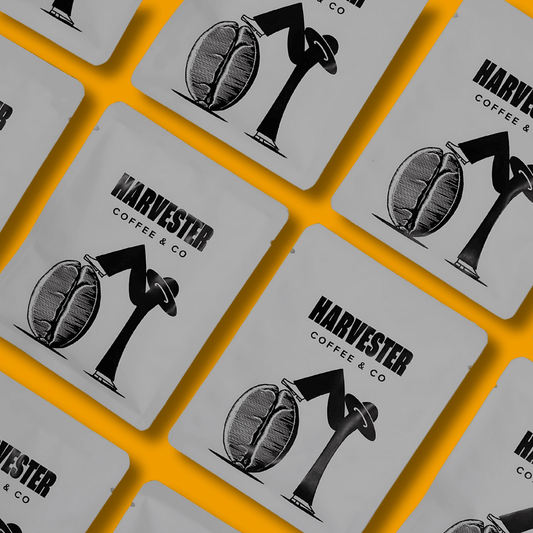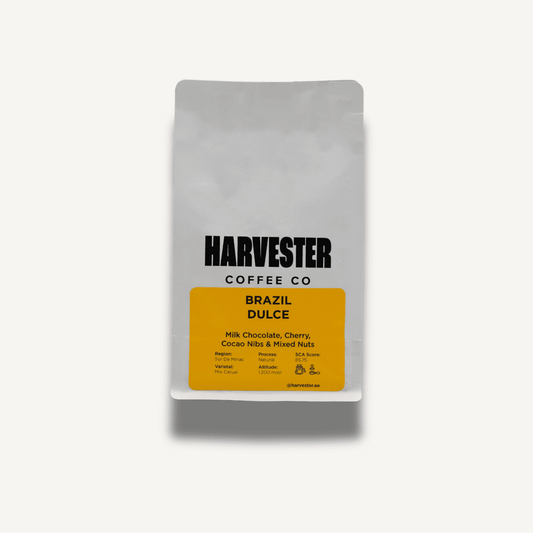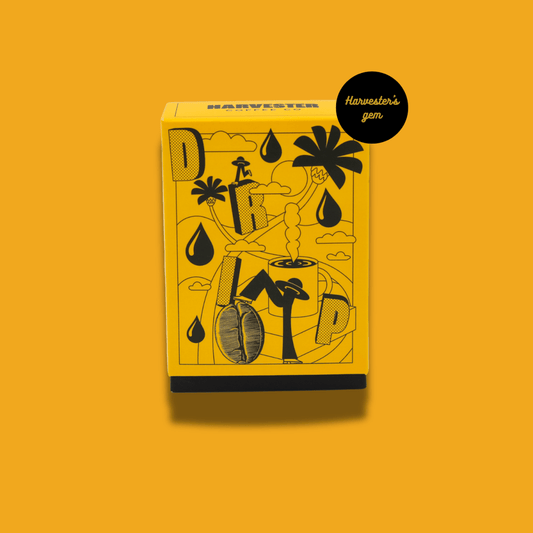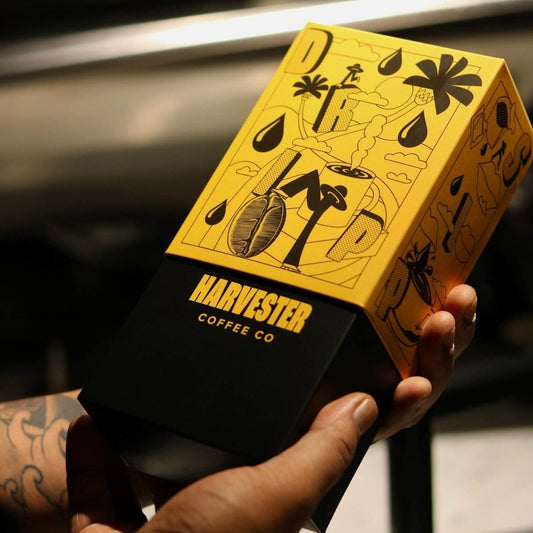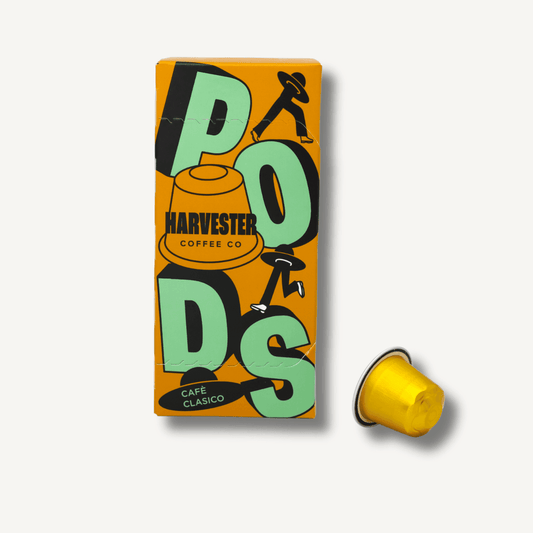Share
Guatemala La Cabaña from Fraijanes – a honey-processed micro-lot showcasing the Anacafé 14 variety’s tropical sweetness.
Guatemala Finca La Cabaña is a standout specialty coffee micro-lot grown at 1,100 MASL in the Fraijanes region of Guatemala. Produced by farmer Gabriel Cordon (Gabriel Cordón) and roasted by Harvester Coffee Co., this coffee is 100% Arabica of the Anacafé 14 cultivar. It’s crafted with the honey process, yielding a cup with vibrant tasting notes of pineapple, tangerine, and chocolate. In this blog post, we explore what makes this coffee unique – from the significance of the honey processing method and the Fraijanes terroir, to the resilience and flavor profile of the Anacafé 14 variety – and offer a brewing recommendation to bring out its best attributes.
Fraijanes Terroir: Volcanic Soils and Unique Microclimate
The Fraijanes Plateau is one of Guatemala’s celebrated coffee-growing regions, known for its volcanic soils and ideal climate. Coffee here is often grown at high elevations on volcanic pumice soil with plenty of rain, nurtured by an active volcano – Volcán Pacaya – that periodically dusts the soil with mineral-rich ash. This ash deposition, along with high concentrations of potassium in the soil, contributes to exceptionally fertile grounds and a full-bodied mouthfeel in the cup. The climate features sunny dry seasons with early morning clouds and mist that burn off quickly, allowing coffee to be sun-dried after harvest. Thanks to this unique terroir, Fraijanes coffees are known for their bright, persistent acidityand well-balanced flavor profile with a defined aroma and body. In the cup, Finca La Cabaña reflects its origin: a juicy brightness (think pineapple and tangerine zest) grounded by a satisfying body and sweetness reminiscent of chocolate. Terroir-driven characteristics like these make Fraijanes coffees stand out to both specialty drinkers and professional cuppers seeking complexity and regional signature.

The Honey Process: Sweetness and Sustainability
One of the key features of Guatemala La Cabaña is its honey processing method. Unlike a fully washed process (which removes all the fruit pulp and mucilage from the coffee bean) or a natural process (which dries the whole cherry intact), the honey process is a hybrid approach. After the coffee cherries are depulped, a portion of the sticky mucilage (fruit flesh) is left clinging to the beans as they dry – the texture resembling honey, which gives the process its name. This method requires careful drying to avoid over-fermentation, but when done well it imparts a remarkable sweetness and depth to the coffee. Honey-processed coffees are renowned for a rounded sweetness and medium body, effectively combining some of the brightness of washed coffees with the deeper fruity notes of natural process. In practice, the honey process often enhances the coffee’s natural sweetness and yields a more syrupy, full mouthfeel compared to a washed coffee. In La Cabaña, the honey process accentuates those pineapple and tangerine tropical fruit notes, while smoothing the acidity and adding a honeyed caramel-chocolate undertone. Beyond flavor, the honey method is also valued in the industry for being relatively eco-friendly – it uses less water than fully washed processing – aligning with sustainable practices. For farmers like Gabriel, this process is a craft that can elevate a coffee’s cup score and value, rewarding the extra labor with a distinctive flavor profile that buyers and roasters appreciate.

Anacafé 14 Cultivar: Resilience Meets Quality
La Cabaña’s varietal, Anacafé 14, is part of a newer generation of Guatemalan Arabica cultivars developed to marry resilience with cup quality. The Anacafé series (named after Guatemala’s National Coffee Association, Anacafé) includes hybrids selected in response to challenges like leaf rust disease and climate variability. These cultivars have been bred by crossing traditional quality Arabicas with hardy disease-resistant lines. Anacafé 14 in particular is celebrated for its resilience – especially its resistance to coffee leaf rust (roya) – and its adaptability to the local growing conditions. It is a high-yielding, hardy plant that was selected for both agronomic performance and cup character. This resilience is crucial for farmers: after the rust epidemic that hit Central America in the early 2010s, having a rust-resistant variety means more stable production and livelihoods. Importantly, Anacafé 14 doesn’t compromise on flavor despite its sturdy genetics. In the cup, it tends to produce a full-bodied and complex profile, with layers of flavor beyond the basic chocolate or nut notes common to many hardy hybrids. Coffee professionals note that these Anacafé cultivars can display floral and fruity aromas alongside the sweetness, making them intriguing for specialty roasters. In La Cabaña’s case, the Anacafé 14 contributes to the coffee’s lively citrus notes and smooth chocolate finish, demonstrating that a resistant variety can also be a flavor-forward one. This balance of farm resilience and cup quality exemplifies the direction of modern coffee cultivation – a point of interest for industry buyers who seek both sustainability and excellence.

Tasting Notes: Pineapple, Tangerine, and Chocolate
From farm to cup, Guatemala La Cabaña delivers a memorable sensory experience. Upon brewing, you’ll notice a fragrant aroma with hints of ripe tropical fruit and sweet raw sugar. The first sip bursts with pineapple brightness – a juicy acidity that is vibrant but not overwhelming. This citrusy sweetness is complemented by notes of tangerine or mandarin orange, giving a crisp and refreshing quality to the cup. As the coffee cools slightly or as you savor the finish, deeper notes of milk chocolate emerge, coating the palate with a smooth sweetness. The balance is striking: the cup is bright yet smooth, with the fruit acidity tempered by honeyed sweetness and cocoa-like depth. The honey processing clearly amplifies the fruit tones and sweetness, while the Fraijanes terroir and Anacafé 14 variety provide a sturdy body and clean finish. Industry cuppers would describe this profile as complex and layered, with a long sweet aftertaste. These tasting notes make La Cabaña appealing to a range of coffee enthusiasts – adventurous black coffee drinkers will enjoy its complexity, while those in the coffee trade recognize its profile as indicative of a high-quality Guatemalan micro-lot.
Brewing Recommendation: Bringing Out the Best
To highlight the exquisite attributes of Finca La Cabaña, we recommend brewing it with methods that accentuate its clarity and sweetness. Pour-over brewing is an excellent choice for this coffee. Using a device like a Hario V60 or Kalita Wave with a medium grind, try a coffee-to-water ratio of about 1:16. Water around 92–94°C (198–202°F) will extract the bright notes without scalding the delicate flavors. Aim for a total brew time of around 3–3½ minutes. This method will emphasize the coffee’s pineapple and tangerine high notes, giving you a clean cup that sparkles with acidity. The sweetness is well-expressed as the cup cools, so take time to notice how the flavors evolve. If you prefer a method that brings out more body and chocolatey richness, a French press at a slightly coarser grind is a great alternative – it will produce a heavier mouthfeel and accentuate those honey and chocolate undertones. Espresso lovers will also find La Cabaña rewarding: as a straight shot, its juicy citrus cuts through with candy-like sweetness, and in milk drinks its chocolate tones create a smooth, caramel-like finish. Whichever method you choose, remember to use fresh, filtered water and let the coffee rest 1-2 weeks post-roast for optimal flavor. With proper brewing, this honey-processed Guatemalan coffee truly shines, delivering the full spectrum of its terroir and processing in the cup.
From Origin to Cup: Why It Matters
Beyond its delightful taste, Guatemala La Cabaña represents the synergy of farmer innovation, regional character, and thoughtful roasting. Each bag tells the story of Gabriel’s farm in Fraijanes and the wider community of Guatemalan coffee growers striving for quality and sustainability. Partnerships in the supply chain – such as sourcing through Hands On Harvest Trade – ensure that this micro-lot is ethically traded and traceable from origin to roaster. By supporting such coffees, specialty roasters and consumers help sustain farmers who invest in processes like honey fermentation and cultivate resilient varieties like Anacafé 14. In turn, the industry is rewarded with coffees that are both reliable in production and exceptional in the cup. Guatemala Finca La Cabaña is more than just a coffee to drink; it’s an educational example of how processing techniques and varietals influence flavor, and an opportunity to taste a piece of Fraijanes terroir in your mug. Whether you’re a coffee aficionado or an industry professional, this honey-processed Fraijanes micro-lot offers a case study in specialty coffee excellence. Enjoying it is not only a treat for the palate but also a nod to the resilient farmers and innovative practices propelling the coffee world forward.
Experience this coffee yourself through the official product listing on Harvester’s website (see the Guatemala La Cabaña listing for details) and learn more about sustainable Guatemalan coffee initiatives at Hands On Harvest Trade.






